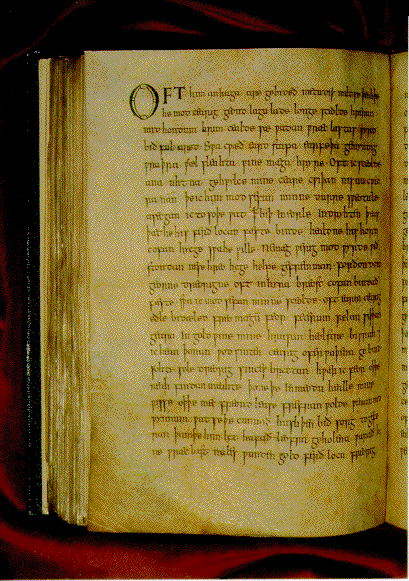
The Exeter Book, folio 76v, "The Wanderer"

The more sharp-eyed among you will be thinking, "Aha! There aren't any casurae (half-line divisions) and the lines are set out like prose, not broken like poetry!" But look more closely, perhaps with a printout of the first ten lines in Old English beside the screen, and you'll see the scribe has left slightly larger spaces at some of the casurae, and in others (according to George Philip Krapp and Elliot Van Kirk Dobbie, editors of the Anglo-Saxon Poetic Records edition) the scribe uses his only punctuation mark, the point or period, to indicate those half-line breaks. Nonetheless, doesn't this challenge, somewhat, our sense of the essential difference between poetry and prose?
The poetry in the Exeter Book's 131 surviving parchment leaves is the largest collection of Old English literature we have, in addition to the Junius MS, the Verecelli Book, MS Cotton Vitellius A.xv ("Beowulf" and "Judith"), and the Paris Psalter. It appears to have been copied by a single scribe, probably in the late 10th century, though "The Wanderer" doubtless is much older, perhaps dating to the conversion of the Anglo-Saxon tribes to Christianity, which began with St. Augstine's mission to the southerners in 597. (The poem's frame narrator offers clearly Christian advice in response to the Wanderer's lament for lost worldly things.) The book contains 31 major poems, as well as 96 riddles. Of course, reading any heavily embedded Old English poetic sentence, with its many kennings (metaphoric phrases), strangely resembles solving a riddle. The other major poems include a life of Christ, a group of maxims set in verse, several poems on the last judgment, the Lord's Prayer, and the following other "elegies" in addition to "Wanderer": "The Seafarer," "Wulf and Eadwacer," "The Wife's Lament," "The Husband's Message," and "The Ruin."
The manuscript survived because it was given by bishop Leofric (d. 1072) to the library of Exeter Cathedral, a building which would escape the dangers of fire and storm, civil war and two world wars. The condition of the manuscript has been described as severely damaged in places, and the editors' note describing this damage may give us some idea what the odds were against the book getting from the scribe's hands to Leofric's, and thence to the relative safety of the cathedral library:
"The fact that folio 8a, the first page preserved of the original manuscript, has been scored over with knife strokes suggests that at one time in its history the book was used as a cutting board. Near the outer margin of this folio, where two very deep strokes came together, a triangular piece has been torn out of the parchment, apparently containing the final n of eadga[n], Christ 20. A vessel containing liquid, perhaps a beer mug, has made a circular stain near the center of fol. 8a. The liquid has been spilled over a large portion of this page, and has gone through the next two folios also, causing a brown stain on these folios and making the text in some places very difficult to read. This severe damage which fol. 8a has suffered indicates that the lost folio at the beginning of the manuscript was detached from the rest of the bok at a very early date, and that from that time on, the book was without a binding at least until after folios 1 to 7 were added at the begining.
[ . . . ] But by far the greatest damage to the manuscript has been done on the last fourteen folios, where a long diagonal burn has destroyed much of the text..." (Krapp and Dobbie xiv-xv).
The Exeter Book. Ed. George Philip Krapp and Elliott Van Kirk dobbie. N.Y.: Columbia UP, 1936.